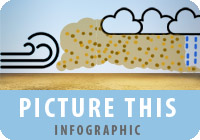The Drought
According to the National Oceanic and Atmospheric Administration (NOAA), the period of 2012-2014 was California’s worst drought in 1,200 years and continues to persist into a dry 2015. California’s Department of Water Resources (DWR) published that the April 2015 annual snowpack measurement in the Sierra Nevada was at the lowest level ever recorded.
Air Quality Effects
Particles – Without any rain, ground surfaces become more dry and thus vehicles can kick up more fugitive dust on roads while winds blow loose soil from areas like dry lakebeds or fallow fields. Fugitive dust in the air can increase the concentration of both coarse and fine particles, which lead to harmful health effects.
Toxics/Pollution – Without rainfall to provide natural irrigation, the drought increases the need for mechanical water pumping, leading to increased emissions from many of the pumps throughout the state that still operate on highly polluting diesel fuel.
Lack of storms – Storms provide two beneficial effects that are lost during a drought: (1) the natural cleansing effect of precipitation and (2) windy, unstable weather helps clear stagnant air that can build up with unhealthy levels of pollution.
Wildfires – Drought has been linked with increased frequency and intensity of wildfires. Wildfire smoke is bad to breathe. It contains ozone-forming pollutants, particulate and air toxics.
Dust Control
The District has a Dust Control page which provides recommendations for practices that help minimize dust in agricultural and construction areas. During the drought, the District advises wise water use for dust control. See tips below. You can also read ARB’s Fugitive Dust Control Self-Inspection Handbook for more information and tips.
Common Dust Control Measures: Start with Preventative Measures
- Minimize size of disturbed/exposed area
- Adjust work schedule (limit dusty work on windy days)
- Eliminate trackout
- Apply dust suppressant (see below)
Dust Control Measures for Occasional Use Areas
- Vegetative ground cover
- Wind erosion controls (e.g. bushes, fence)
- Apply dust suppressant (see below)
Dust Control Measures for Frequent Use Areas
- Pave haul roads/lots (at least entrance/exit)
- Place a layer of stone/coarse aggregate
- Enclose material storage/handling
- Cover material storage piles
- Sweep surfaces often
- Reduce speed limits
- Apply dust suppressant (see below)
Fugitive Dust Control
Storage Piles
- Enclose storage and handling areas
- Cover piles when not in use
- Use dust suppression measures when needed (see below)
Earth Moving
- Conduct activity on less windy days
- Reduce wind effects with windbreaks where practicable
- Require tarpaulins for all haul vehicles
Dust Suppressants
Dust suppressants are chemicals whose purpose is to attract moisture and bind dust particles to seal the surface against dust emissions. Common ones besides water include:
- Chloride salts
- Lignin (pulp/paper by-product)
- Vegetable-based products
- Other approved organic products
- Polymer solutions
- Emulsified asphalt or resin solutions


